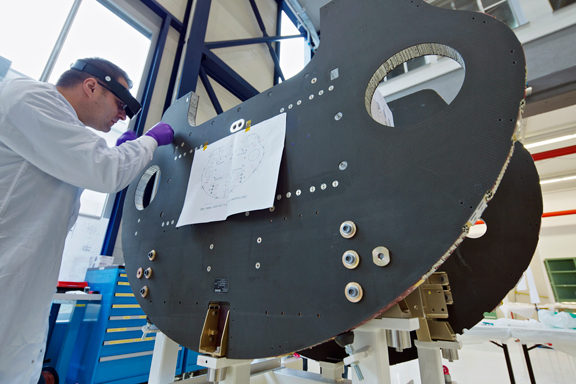[SatNews] Europe’s experimental space ferry IXV (Intermediate eXperimental Vehicle) is ready for take-off.
The autonomous spacecraft is scheduled to launch aboard a Vega rocket from the European spaceport in Kourou, French Guiana, on February 11th.

A RUAG technician assembles a module for the IXV Cold Structure.
Photo courtesy of RUAG Space.
RUAG Space supplied what is known as the cold structure for IXV. Similar to the self-supporting body of an automobile, the cold structure is what actually carries the load. It gives IXV its aerodynamic shape and provides the mechanical interfaces to the launcher and to all of the spacecraft’s other assemblies. At several points during the various mission phases, the cold structure must withstand considerable forces – when it takes off from Kourou on board the Vega rocket, when it re-enters the Earth’s atmosphere, as the parachute opens, and finally when it lands in the Pacific.
IXV is a chance for the European Space Agency ESA to test out key technologies for re-entry into Earth’s atmosphere and for the autonomous return of spacecraft to Earth. Particular focus is on aerodynamics and aerothermodynamics as well as the heat shield, navigation and avionics. There are any number of applications for an autonomous spacecraft that can return to Earth undamaged. These range from research in zero-gravity conditions and exploration of the upper atmosphere, to maintenance and service missions for satellites or the International Space Station ISS. Another possibility is transporting rock samples from other planets back to Earth.
At 5 meters long, 1.5 meters high and 2.2 meters wide, the Intermediate eXperimental Vehicle is about the size of an average car and weighs almost two tons. A Vega launcher will take the spacecraft up to around 320 kilometers. After separation, IXV will climb to around 450 kilometers before turning back to Earth. It will re-enter the Earth’s atmosphere around 120 kilometers above the surface, travelling at some 27,000 kilometers per hour. After re-entry, a parachute will open to slow the spacecraft down. The full mission will take 1 hour and 40 minutes, after which time IXV will touch down in the Pacific Ocean.
During its flight, the autonomous spacecraft will perform a whole series of precisely programmed maneuvers, which will provide engineers and scientists with the data they need to test technologies that are crucial for re-entry.
RUAG Space was responsible for supplying all IXV’s instruments, which comprise some 300 temperature, pressure and position sensors and strain gauges. The sensors have to be able to deliver reliable measurements while withstanding temperatures of up to 1,600 degrees Celsius. In collaboration with ETH Zurich and Lambda-X in Belgium, RUAG Space also supplied an infrared camera, which will take high-resolution pictures of one of the two control flaps throughout re-entry. This will provide information regarding what temperatures IXV experienced at every point during re-entry and the physical effects these temperatures have.
Please visit http://www.ruag.com/space/space-home/ for additional information regarding RUAG Space.


